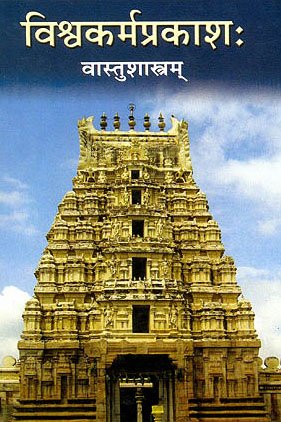Dhanurgraha, Dhanus-graha, Dhanugrraha: 9 definitions
Introduction:
Dhanurgraha means something in Hinduism, Sanskrit. If you want to know the exact meaning, history, etymology or English translation of this term then check out the descriptions on this page. Add your comment or reference to a book if you want to contribute to this summary article.
In Hinduism
Vastushastra (architecture)
Source: Wisdom Library: Vāstu-śāstraDhanurgraha (धनुर्ग्रह) is the Sanskrit name for a unit of measurement, used in Vāstuśāstra literature, according to the Mānasāra II.40-53. A single Dhanurgraha unit corresponds to 27 Aṅgula units.
Below follows a table of the different units of measurement in relation to one another:
- 8 Paramāṇu = 1 Rathadhūli, chariot-dust
- 8 Rathadhūli = 1 Vālāgra, hair-end
- 8 Vālāgra = 1 Likṣā, nit,
- 8 Likṣā = 1 Yūka, louse
- 8 Yūka = 1 Yava, barley-corn,
- 8 Yava = 1 Aṅgula, digit (finger-breadth),
- 12 Aṅgula = 1 Vitasti, span,
- 2 Vitasti (24 aṅgulas) = 1 Kiṣku, cubit,
- 4 Dhanurmuṣṭi (26 aṅgulas) = 1 Daṇḍa, rod,
- 8 Daṇḍa = 1 Rajju, rope
The smallest unit, which is paramāṇu, atom is stated ta be perceived (only) by the sages. For all practical purposes, aṅgula is the smallest unit of measurement. For this reason, it is seen to be treated in a special way in the text with regards to its universality that significantly downplays its semantic reference to the body.

Vastushastra (वास्तुशास्त्र, vāstuśāstra) refers to the ancient Indian science (shastra) of architecture (vastu), dealing with topics such architecture, sculpture, town-building, fort building and various other constructions. Vastu also deals with the philosophy of the architectural relation with the cosmic universe.
Shilpashastra (iconography)
Source: Shodhganga: The significance of the mūla-beras (śilpa)Dhanurgraha (धनुर्ग्रह) refers to a “bowlength” type of absolute measurement, as defined in the texts dealing with śilpa (arts and crafs), known as śilpaśāstras.—In the Indian value of measurement of length there are two different kinds of units, namely, the absolute and the relative. Of these, the first is based on the length of certain natural objects, while the second is obtained from the length of a particular part or limb of the person whose measurement is under consideration. They have been specified by R. N. Mishra, in his text in volume 1 of Kalātattvakośa.
26 mānāṅgulas make 1 dhanur-graha (bowlength).

Shilpashastra (शिल्पशास्त्र, śilpaśāstra) represents the ancient Indian science (shastra) of creative arts (shilpa) such as sculpture, iconography and painting. Closely related to Vastushastra (architecture), they often share the same literature.
Languages of India and abroad
Sanskrit dictionary
Source: DDSA: The practical Sanskrit-English dictionaryDhanurgraha (धनुर्ग्रह).—a measure, a cubit of 27 aṅgulas; Māna.2.52.
Derivable forms: dhanurgraham (धनुर्ग्रहम्).
Dhanurgraha is a Sanskrit compound consisting of the terms dhanus and graha (ग्रह).
Source: Cologne Digital Sanskrit Dictionaries: Benfey Sanskrit-English DictionaryDhanurgraha (धनुर्ग्रह).—m. 1. an archer, [Rāmāyaṇa] 2, 44, 18. 2. Archery, Mahābhārata 12, 7662.
Dhanurgraha is a Sanskrit compound consisting of the terms dhanus and graha (ग्रह).
--- OR ---
Dhanurgrāha (धनुर्ग्राह).—m. an archer, Mahābhārata 3, 1430.
Dhanurgrāha is a Sanskrit compound consisting of the terms dhanus and grāha (ग्राह).
Source: Cologne Digital Sanskrit Dictionaries: Cappeller Sanskrit-English DictionaryDhanurgraha (धनुर्ग्रह).—[masculine] bowman, archer.
--- OR ---
Dhanurgrāha (धनुर्ग्राह).—[masculine] bowman, archer.
Source: Cologne Digital Sanskrit Dictionaries: Monier-Williams Sanskrit-English Dictionary1) Dhanurgraha (धनुर्ग्रह):—[=dhanur-graha] [from dhanur > dhanu] m. bearing a b°, an archer, [Rāmāyaṇa]
2) [v.s. ...] the art of managing a b°, [Mahābhārata]
3) [v.s. ...] Name of a son of Dhṛta-rāṣṭra, [ib.]
4) Dhanurgrāha (धनुर्ग्राह):—[=dhanur-grāha] [from dhanur > dhanu] ([Mahābhārata]) m. an archer.
[Sanskrit to German]
Sanskrit, also spelled संस्कृतम् (saṃskṛtam), is an ancient language of India commonly seen as the grandmother of the Indo-European language family (even English!). Closely allied with Prakrit and Pali, Sanskrit is more exhaustive in both grammar and terms and has the most extensive collection of literature in the world, greatly surpassing its sister-languages Greek and Latin.
Kannada-English dictionary
Source: Alar: Kannada-English corpusDhanugrraha (ಧನುಗ್ರ್ರಹ):—
1) [noun] a man who shoots with bow and arrow.
2) [noun] a linear measure equal to twenty seven inches.
Kannada is a Dravidian language (as opposed to the Indo-European language family) mainly spoken in the southwestern region of India.
See also (Relevant definitions)
Partial matches: Dhanus, Graha.
Starts with: Dhanurgrahakara.
Full-text: Dhanurdhara, Angula, Manangula, Kishku, Graha.
Relevant text
Search found 7 books and stories containing Dhanurgraha, Dhanugrraha, Dhanur-graha, Dhanur-grāha, Dhanurgrāha, Dhanus-graha, Dhanus-grāha; (plurals include: Dhanurgrahas, Dhanugrrahas, grahas, grāhas, Dhanurgrāhas). You can also click to the full overview containing English textual excerpts. Below are direct links for the most relevant articles:
Manasara (English translation) (by Prasanna Kumar Acharya)
Chapter 2 - The Qualifications of Architects and the system of Measurement
Chapter 19 - The one-storeyed buildings (ekatala or ekabhūmi)
Kautilya Arthashastra (by R. Shamasastry)
Chapter 20 - Measurement of Space and Time < [Book 2 - The duties of Government Superintendents]
Kashyapa Shilpa-shastra (study) (by K. Vidyuta)
4. Technicalities (a): Mānāṅgula Measurements < [Chapter 2 - Author and his Works]
Mahabharata (English) (by Kisari Mohan Ganguli)
List of Mahabharata people and places (by Laxman Burdak)
Chapter 4 - The Death of Karna < [Karna Parva]